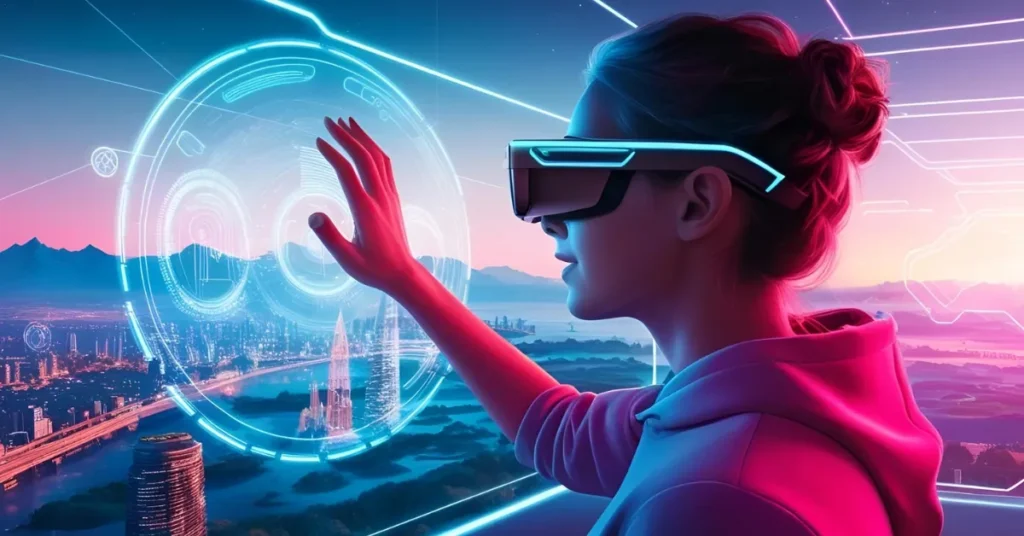Augmented Reality (AR) represents a transformative technology that overlays digital content onto the physical world, enhancing how we interact with our environment. From navigating cities with digital directions to virtually trying on clothes, AR is reshaping industries and daily experiences. Its market, valued at $83.65 billion in 2024, is projected to reach $120.29 billion by 2025 and nearly $600 billion by 2030, reflecting its growing significance (Grand View Research). This article explores the future of AR, detailing current applications, emerging trends, future possibilities, challenges, and expert insights, providing a comprehensive overview for professionals and enthusiasts alike.

Current State of Augmented Reality Technology
AR is already integrated into various aspects of modern life. Social media platforms like Snapchat and Instagram utilise AR filters to add digital effects, such as virtual makeup or animated characters, to users’ faces. In gaming, applications like Pokémon Go blend virtual elements with real-world locations, creating immersive experiences. Retail applications, such as IKEA Place, enable customers to visualise furniture in their homes before purchasing, enhancing decision-making.
The primary devices for AR are smartphones and tablets, leveraging platforms like Google’s ARCore and Apple’s ARKit to deliver seamless experiences. Additionally, wearable devices, including the Apple Vision Pro and Meta Quest, are gaining traction, offering more immersive AR capabilities. These advancements indicate AR’s accessibility and its potential for further integration into daily routines.

Key Trends Shaping the Future of AR
Several trends are poised to define the future of AR, driven by technological advancements and increasing adoption across industries. Below are the most significant developments expected in 2025 and beyond:
AI Integration in AR
Artificial Intelligence (AI) is enhancing AR by improving object recognition, human scanning, and real-time data processing. For instance, AI enables applications to identify products and provide instant information, such as reviews or specifications. A notable example is an AR router setup app that uses AI to guide users through installation, demonstrating practical business applications (MobiDev).
Mobile AR Expansion
Initially driven by gaming, mobile AR is expanding into business applications, supported by advancements in 5G networks. These networks provide faster data speeds and lower latency, enabling complex AR experiences. Companies are using AR for virtual training, maintenance guides, and customer engagement, transforming operational efficiency.
WebAR Accessibility
WebAR allows users to access AR experiences through web browsers, eliminating the need for dedicated applications. This accessibility is driving adoption in marketing and e-commerce, where businesses create virtual try-on experiences or interactive product demonstrations. For example, retailers offer WebAR features to visualise products in customers’ spaces, enhancing engagement (Yord Studio).
Wearable AR Devices
The development of lightweight, stylish AR glasses is critical for mainstream adoption. Devices like the Apple Vision Pro and Meta Ray-Ban Stories are paving the way, integrating AR with everyday functionalities like navigation and media capture. As these devices evolve, they are expected to become integral to daily life.
AR in Navigation
AR is revolutionising navigation, both indoors and outdoors. Indoor navigation systems use beacons and Visual Positioning Systems (VPS) to guide users through complex environments like malls or hospitals. Outdoor AR navigation overlays directions onto the physical world, enhancing user experiences in urban or natural settings.
AR in Marketing
AR is proving effective in marketing, with studies indicating a 90% increase in brand awareness through AR advertisements, which are 59% more cost-effective than traditional methods (MobiDev). Travel companies, for instance, use AR to offer virtual destination tours, boosting customer engagement.
AR in Healthcare
In healthcare, AR supports surgical planning, medical training, and diagnostics. Applications include real-time data overlays during surgeries and tools like Google’s AR Microscope for cancer detection. Johns Hopkins University performed pioneering AR-assisted surgeries in 2020, highlighting its potential (Johns Hopkins).
AR in Retail
Retail is embracing AR for virtual try-ons, allowing customers to preview clothing, makeup, or accessories. A McKinsey survey found that 48% of consumers are interested in AR shopping experiences, driving adoption and reducing return rates (MobiDev).
AR in Manufacturing
AR enhances manufacturing processes by providing workers with real-time instructions for assembly, maintenance, and quality control. This reduces errors and increases efficiency, though challenges like usability in noisy environments persist.
AR in Automotive
The automotive industry leverages AR for virtual showrooms, remote assistance, and heads-up displays that enhance driver safety. Innovations like 3D parking spot detection are also emerging, streamlining user experiences.
Metaverse and AR
The metaverse, a shared virtual space, relies heavily on AR to blend digital and physical worlds. Social AR applications, such as digital avatars, are gaining traction, enabling new forms of interaction and commerce (Ciklum).

Future Applications of Augmented Reality
Beyond current trends, AR holds potential for transformative applications:
- Education: AR can create immersive learning environments, allowing students to explore historical events or scientific concepts in 3D. For example, virtual dissections or historical site tours can enhance engagement.
- Remote Work: AR could enable virtual collaboration spaces where teams interact with 3D models, improving remote work efficiency.
- Social Interactions: AR-enhanced communication could make virtual meetings more expressive, simulating in-person interactions.
- Entertainment: Next-generation gaming and interactive media will leverage AR to offer personalised, immersive experiences.
Challenges and Opportunities
Despite its potential, AR faces several challenges:
- Technical Limitations: Current devices often have limited fields of view, battery life constraints, and processing power requirements.
- User Adoption: AR must provide clear value to overcome perceptions of being a novelty. Intuitive interfaces are essential.
- Privacy and Ethics: AR’s data collection capabilities raise concerns about surveillance and invasive advertising. Regulatory compliance, such as HIPAA in healthcare, is critical (MobiDev).
These challenges present opportunities for innovation. Companies addressing technical and ethical issues will lead the AR market, creating new business models and enhancing user trust.
Expert Predictions for AR’s Future
Industry leaders offer valuable insights into AR’s trajectory. Yann LeCun, Chief AI Scientist at Meta, predicts that “smart glasses with displays and EMG interfaces are coming in the next year, full augmented reality glasses in a few years,” suggesting a future where AR integrates with AI-driven agents (Yann LeCun X Post). Conversely, John Carmack, a virtual reality pioneer, notes that “even the best lab demos of AR glasses today are not the holy vision of ‘augmenting reality’ that Mark Zuckerberg and Tim Cook are both chasing,” indicating ongoing technical hurdles (John Carmack X Post).
These perspectives highlight both optimism and realism, suggesting that while AR is advancing, achieving seamless integration requires further innovation.
Conclusion
The future of AR is poised for significant growth, driven by technological advancements and expanding applications across industries. From AI-enhanced experiences to accessible WebAR and wearable devices, AR is set to transform how we work, learn, and interact. While challenges like privacy and technical limitations persist, the opportunities for innovation are vast. Professionals and businesses are encouraged to explore AR’s potential, leveraging its capabilities to stay competitive in a rapidly evolving technological landscape.
Frequently Asked Questions
1. What is the difference between AR and VR?
Augmented Reality enhances the real world with digital overlays, while Virtual Reality creates a fully immersive digital environment, replacing the physical world.
2. How will AR impact the job market?
AR is likely to create opportunities in development, design, and content creation, while transforming roles in training, maintenance, and customer service.
3. What are the privacy concerns with AR?
AR devices collect extensive data, raising risks of surveillance, data breaches, and unauthorised advertising, necessitating robust privacy measures.
4. How can businesses leverage AR?
Businesses can use AR for marketing, customer engagement, training, and product visualisation, enhancing efficiency and customer experiences.
5. What are some free AR tools to try?
Explore AR through Google Search’s 3D animal feature, Snapchat filters, or the IKEA Place app, which offer accessible, user-friendly experiences.
Know More
For additional insights, explore related articles on emerging technologies and digital transformation at daytalk.in.

